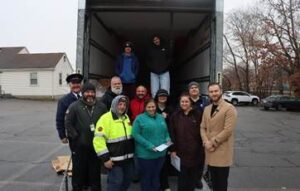Do you know how much you’ll be paid for your work today? How about tomorrow? The answers to these questions can be easy for people who are paid by salary, by the hour or even by the mile, as is the case with many truck drivers.
It’s different for most owner-operators.
When you own your own trucking business the answers are more complicated. There are more variables involved, starting with what you’ll be paid to haul a load.
Unfortunately, all too many truck owners make load acceptance decisions based on the wrong reasons.
Know your cost per mile.
Before you can decide what rates are “good” for any load, it’s important to know your operational cost per mile. Obviously, if your cost to operate is $2 per mile and a load is offering $1.80 per mile for transport, you’ll lose money on the deal — not to mention putting more wear and tear on your equipment.
If you don’t know your operating cost, you can’t make sound decisions about rates.
Be sure you understand the truck-freight market cycle.
Unless you have a contract with specific customers, you’re likely to be at the mercy of the freight spot rate market. Like other markets, the freight market is governed by the law of supply and demand, with “demand” being the amount of freight being offered for transport and “supply” being the number of trucks available to haul that freight.
We saw an excellent example of the impact of supply and demand just a few years ago during the COVID-19 pandemic.
Because of mandated shutdowns, carriers laid off drivers and parked trucks. The government extended unemployment benefits far beyond usual limits, creating an incentive for those laid off drivers to remain at home.
In the meantime, products continued to move, creating a large demand for the dwindling supply of available trucks. The results were record-high freight rates and a boom in the truck sales market. Everyone wanted to be an owner-operator.
Once the supply of trucks exceeded the demand, however, freight rates came crashing down. Truck loan defaults set records as carriers closed their doors.
The truck-freight cycle continues: When rates are high, more trucks are sold. When the market is saturated with more trucks than needed, rates come down. When rates come down, fewer trucks are sold. Rinse and repeat.
Today, we’re still at the too-many-trucks-for-available-freight stage, with slow improvement expected.
Even so, you can still operate a successful small trucking business. However, doing so IS more difficult. It requires belt-tightening and tight control of expenses — and it requires sound decision-making about what loads to haul.
Seize opportunities to succeed.
In addition, there are freight market conditions that apply locally and regionally, and sometimes even by the calendar.
For example, Mother’s Day creates an aberration in the freight market each May:
For much of the year, many independent drivers avoid hauling loads to Florida. While the rates for incoming freight may be viable, loads coming out of Florida are notoriously low paying.
Why? Because Florida is a consumer state. A growing population needs food, paper products, appliances and other everyday items. There’s lots of freight going in — but because much of the population is retired, there isn’t a lot of manufacturing going on.
That means there’s not much freight coming out of Florida, and all those trucks that delivered products into the state are competing for the few available loads.
However … each year, Mother’s Day results in a large demand for refrigerated trucks in South Florida.
Did you send your mother or wife flowers? So did millions of other Americans — and those flowers were likely imported from South America and entered the U.S. through ports in Florida. There are so many loads of flowers, in fact, that competition for available trucks goes through the roof.
For a few days each May, it can be lucrative to be in Miami with an available refrigerated trailer.
Such opportunities happen every day.
Some happen because areas of the country have more freight coming in than going out, or vice versa.
Some destinations always pay well. Others don’t pay much to get there, but outbound loads pay very well.
Some situations are temporary: A weather disaster creates a need for building materials. A perishable crop is harvested and must be hauled to destination quickly. A snowstorm causes railroad delays, causing a product shortage.
Be aware of “the rest of the story.”
While it’s always great to find a load on a load board that pays well, that’s only part of the equation.
Where will you get the load after that, and what will it pay? If you’re headed for a destination with low paying outbound freight, you’ll need to deadhead for a longer distance for your next load — unless you agree to take a lower rate for one that’s closer.
Understanding how rates work allows you to schedule your hauling to take advantage of the highest rates. That may mean changing your usual travel patterns, visiting new areas or perhaps traveling in a “triangle” between three cities instead of simply back and forth between two.
It’s helpful if you’re flexible about getting home, too. While there are certainly considerations that are more important than dollars — such as family relationships, you’ll want to find a balance so that you’re able to maximize your earnings while you’re away from home.
Learn all you can about the freight market.
Many of the firms that offer load board services also offer educational videos, informative blogs and white papers, and other educational resources — and some offer expert consultation for an additional charge.
DAT Freight and Analytics offers the largest load board in the country, as well as “DAT University,” which offers free online courses taught by industry experts.
Truckstop.com, the next-largest public load board, offers free training articles and blog posts, as well as a forum where you can discuss business with others.
Another resource is C.H. Robinson, where you can find videos, blog posts and market information; check under the “Resource” tab on the home page.
There are also analytic firms that large carriers pay to help them understand trucking business trends and economic conditions. While you may not choose to engage their services, you can benefit from reading their educational blog posts or attending webinars they conduct, many of them free of charge.
ACT Research and FTR Transportation Intelligence are two firms that analyze conditions and forecast the economy, sharing a portion of their expertise with the public free of charge. Other resources are available; just do a quick internet search.
Education — much of it free — about the trucking industry and freight market is available to anyone with internet access.
By learning your freight market and considering where the next load (and the one after that, and one after that) are coming from, you’ll increase your earnings. Isn’t that why you’re out here on the road to start with?
Cliff Abbott is an experienced commercial vehicle driver and owner-operator who still holds a CDL in his home state of Alabama. In nearly 40 years in trucking, he’s been an instructor and trainer and has managed safety and recruiting operations for several carriers. Having never lost his love of the road, Cliff has written a book and hundreds of songs and has been writing for The Trucker for more than a decade.















